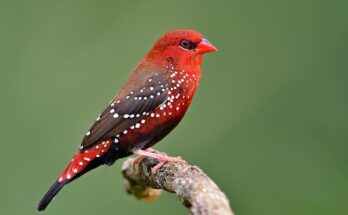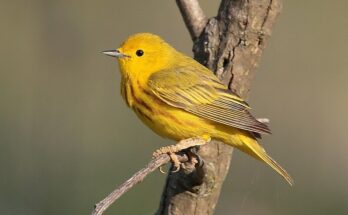Birds with red beaks are some of the most striking creatures in nature. Their vibrant beaks aren’t just for looks—they help with feeding, attracting mates, and more. I’ve researched 15 incredible species, each with a unique story to tell. From colourful kingfishers to elegant terns, these birds are fascinating. Whether in forests or on coastlines, they captivate. Let’s dive into the world of these amazing red-beaked birds!
1. Northern Cardinal
- Scientific Name: Cardinalis cardinalis
- Size: 8.3 to 9.3 inches (21-23 cm)
- Weight: 1.5 to 1.7 oz (42-48 g)
- Lifespan: Up to 15 years
- Diet: Seeds, grains, fruits, and insects
The Northern Cardinal is one of the most iconic birds in North America, known for its bright red feathers and striking red beak. Male cardinals, with their vivid red plumage, are easy to spot, while females have more muted brown tones with hints of red. Cardinals are often found in gardens, woodlands, and parks across the eastern and central United States. Their cheerful songs are a familiar sound in many neighbourhoods.
Cardinals are non-migratory, meaning they can be seen year-round in their habitats. Their red beaks crack open seeds, their primary food source. They also eat fruits and insects, especially during the breeding season when they need extra protein for their young.
2. Black Oystercatcher (Haematopus bachmani)
- Scientific Name: Haematopus bachmani
- Size: 16 to 18 inches (40-46 cm)
- Weight: 1.5 to 2 pounds (700-900 g)
- Lifespan: Up to 15 years
- Diet: Mussels, limpets, and other shellfish
The Black Oystercatcher is a striking shorebird, known for its entirely black plumage and bright red beak. Found along the rocky coastlines of the Pacific, from Alaska to Baja California, this bird’s specialized beak is perfect for prying open shellfish such as mussels and limpets. Its long, sturdy beak allows it to access food that other birds can’t reach, making it a unique predator along the shore.
Black Oystercatchers are monogamous, often pairing for life. They are highly territorial and will fiercely protect their feeding grounds and nests from intruders. The bright red colour of their beaks is thought to play a role in courtship and signalling to other oystercatchers.
3. Red-Billed Chough (Pyrrhocorax pyrrhocorax)
- Scientific Name: Pyrrhocorax pyrrhocorax
- Size: 15 to 16 inches (39-41 cm)
- Weight: 10 to 12 oz (284-340 g)
- Lifespan: Up to 17 years
- Diet: Insects, larvae, and fruits
The Red-Billed Chough is a member of the crow family, easily identified by its glossy black feathers and bright red, curved beak. Native to mountainous regions and coastal cliffs in Europe and Asia, the Red-Billed Chough is known for its acrobatic flying and playful behaviour. These birds are highly social and are often seen in flocks, foraging for insects and other invertebrates in short grassland habitats.
The Red-Billed Chough’s red beak is not just for show. It is an essential tool for probing the ground for food. Their loud, ringing calls are a common sound in their habitats, especially when they are flying in large groups.
4. Red-Billed Tropicbird (Phaethon aethereus)
- Scientific Name: Phaethon aethereus
- Size: 30 to 32 inches (76-81 cm)
- Weight: 1 to 1.5 pounds (500-700 g)
- Lifespan: Up to 16 years
- Diet: Fish and squid
The Red-Billed Tropicbird is a beautiful seabird known for its slender, white body and long tail feathers. It is often found in tropical and subtropical oceans. Its sharp, red beak stands out against its mostly white plumage. Tropicbirds are excellent fliers, often hovering over the ocean before diving down to catch fish and squid.
These birds breed on isolated islands, laying their eggs in crevices or on the ground. The tropicbird’s red beak is an important feature during courtship displays, where males perform aerial acrobatics to attract females. Their long tails also add to their elegant appearance as they glide over the ocean.
5. Green Wood Hoopoe (Phoeniculus purpureus)
- Scientific Name: Phoeniculus purpureus
- Size: 15 to 17 inches (38-44 cm)
- Weight: 2 to 3 oz (60-85 g)
- Lifespan: Up to 10 years
- Diet: Insects, larvae, and small reptiles
The Green Wood Hoopoe is a fascinating bird native to sub-Saharan Africa, recognized by its iridescent green feathers and bright red beak. These birds live in large groups and are known for their cooperative behaviour, often working together to find food or raise their young. Their long, curved red beak is perfect for probing tree bark in search of insects and larvae.
Wood Hoopoes are very vocal, using a variety of calls to communicate with their group members. Their vibrant plumage and bright red beaks make them a striking sight as they move through the trees in search of food.
6. Rose-Ringed Parakeet (Psittacula krameri)
- Scientific Name: Psittacula krameri
- Size: 15 to 16 inches (38-41 cm)
- Weight: 4.2 to 4.6 oz (120-130 g)
- Lifespan: Up to 30 years
- Diet: Fruits, seeds, and grains
The Rose-Ringed Parakeet, also known as the Ring-Necked Parakeet, is a bright green parrot with a distinctive red beak. Native to Africa and South Asia, these birds have also become established in many urban areas around the world. They are highly adaptable and can thrive in various environments, from forests to city parks.
Their red beaks are used to crack open seeds and fruits, which make up the majority of their diet. Rose-ringed parakeets are social birds, often seen in flocks, and they are known for their loud, chattering calls.
7. Black Stork (Ciconia nigra)
- Scientific Name: Ciconia nigra
- Size: 37 to 40 inches (95-100 cm)
- Weight: 5 to 7 pounds (2.3-3.2 kg)
- Lifespan: Up to 18 years
- Diet: Fish, amphibians, and insects
The Black Stork is a large migratory bird found in parts of Europe, Asia, and southern Africa. Unlike the more familiar White Stork, it has dark plumage with a shimmering green and purple sheen, complemented by a striking red beak and legs. These birds prefer remote wetlands and forests, where they build large nests high in trees.
Read More: 9 Types Of Finches In Hawaii
Black Storks are shy and elusive, often keeping to themselves in quiet habitats. Their red beaks are used to catch fish, amphibians, and small mammals, making them effective hunters in their aquatic environments.
8. Common Waxbill (Estrilda astrild)
- Scientific Name: Estrilda astrild
- Size: 4 to 5 inches (10-12 cm)
- Weight: 0.24 to 0.35 oz (7-10 g)
- Lifespan: Up to 10 years
- Diet: Seeds and small insects
The Common Waxbill Birds With Red Beaks is a small, delicate bird native to sub-Saharan Africa that has since spread to various other regions, including Europe and the Americas. These tiny birds are easily recognized by their slender red beaks and fine red line running from the beak to the eye. Their small size and soft, colourful plumage make them a favourite among birdwatchers.
Waxbills live in flocks and are often seen flitting through grasslands and near water sources, searching for seeds and small insects. Their red beaks are perfectly shaped for picking up tiny seeds from the ground.



